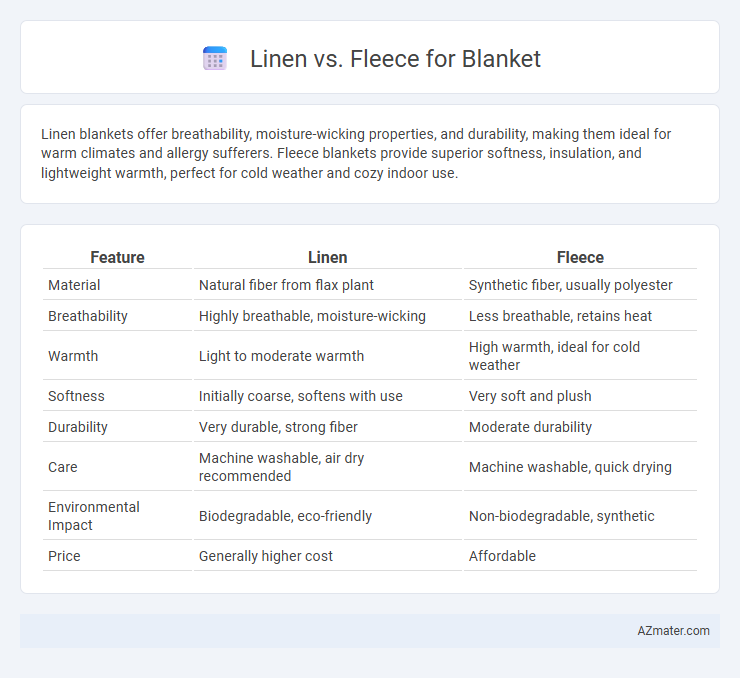Linen blankets offer breathability, moisture-wicking properties, and durability, making them ideal for warm climates and allergy sufferers. Fleece blankets provide superior softness, insulation, and lightweight warmth, perfect for cold weather and cozy indoor use.
Table of Comparison
| Feature | Linen | Fleece |
|---|---|---|
| Material | Natural fiber from flax plant | Synthetic fiber, usually polyester |
| Breathability | Highly breathable, moisture-wicking | Less breathable, retains heat |
| Warmth | Light to moderate warmth | High warmth, ideal for cold weather |
| Softness | Initially coarse, softens with use | Very soft and plush |
| Durability | Very durable, strong fiber | Moderate durability |
| Care | Machine washable, air dry recommended | Machine washable, quick drying |
| Environmental Impact | Biodegradable, eco-friendly | Non-biodegradable, synthetic |
| Price | Generally higher cost | Affordable |
Introduction to Linen and Fleece Blankets
Linen blankets, crafted from natural flax fibers, offer exceptional breathability, moisture-wicking properties, and durability, making them ideal for warm climates and sensitive skin. Fleece blankets, made from synthetic polyester, provide superior insulation, softness, and lightweight warmth, suitable for cold weather and cozy indoor use. Choosing between linen and fleece blankets depends on preferences for temperature regulation, texture, and environmental impact.
Overview: What is Linen?
Linen is a natural fiber derived from the flax plant, renowned for its durability, breathability, and moisture-wicking properties. This fabric offers a lightweight yet strong texture, making it an ideal choice for blankets in warm climates due to its ability to keep users cool and comfortable. Linen blankets are hypoallergenic and become softer with each wash, providing a sustainable and long-lasting option compared to synthetic materials like fleece.
Overview: What is Fleece?
Fleece is a synthetic fabric made primarily from polyester fibers, designed to mimic the softness and warmth of wool while remaining lightweight and breathable. Its moisture-wicking properties and quick-drying capabilities make fleece blankets ideal for outdoor activities and cold climates. With a plush texture and high insulation, fleece offers warmth without the weight, contrasting with the natural, breathable qualities of linen.
Comfort and Softness Comparison
Linen blankets offer breathability and a naturally textured softness that improves with each wash, providing a cool and comfortable feel ideal for warmer climates. Fleece blankets deliver superior plushness and warmth through their dense, synthetic fibers, making them exceptionally soft and cozy for colder environments. The choice between linen and fleece depends on the desired balance between cooling comfort and insulating softness.
Warmth and Insulation Properties
Linen blankets offer excellent breathability and moisture-wicking properties, making them ideal for moderate warmth and preventing overheating. Fleece blankets provide superior insulation with a dense fabric structure that traps heat efficiently, ensuring optimal warmth in colder environments. Choosing between linen and fleece depends on the balance between breathability and maximum thermal retention needed for comfort.
Breathability and Moisture Management
Linen blankets excel in breathability due to their natural fiber structure, allowing air to circulate freely and reducing heat buildup. Fleece blankets, made from synthetic fibers, trap warmth but can retain moisture, leading to less effective moisture management. For those prioritizing a cooler, drier sleep environment, linen is the superior choice thanks to its enhanced moisture-wicking properties and superior ventilation.
Durability and Longevity
Linen blankets offer exceptional durability due to their strong natural flax fibers, which become softer and more resilient with use and washing. Fleece blankets, made from synthetic polyester, provide good durability but tend to pill and degrade faster over time compared to linen. The long-lasting quality of linen makes it a superior choice for blankets intended to withstand years of regular use while maintaining texture and strength.
Ease of Care and Maintenance
Linen blankets are highly durable and become softer with each wash, requiring minimal care such as gentle machine washing in cold water and air drying to prevent shrinkage. Fleece blankets are low-maintenance, offering easy machine wash and quick drying, but they may attract lint and require occasional pilling removal to maintain softness. Both fabrics provide convenience, but linen's natural breathability and sturdiness make it ideal for long-term use with simple upkeep.
Sustainability and Eco-Friendliness
Linen blankets, made from flax fibers, offer exceptional sustainability due to their biodegradability and minimal water usage during cultivation, making them an eco-friendly choice. Fleece blankets, often crafted from synthetic polyester derived from petroleum, pose environmental challenges related to non-biodegradability and microplastic pollution during washing. Choosing linen supports renewable agriculture and reduces carbon footprint, whereas fleece contributes to plastic waste and environmental degradation.
Which Blanket Material is Right for You?
Linen blankets offer exceptional breathability and moisture-wicking properties, making them ideal for warm sleepers or summer use, while fleece blankets provide superior warmth and softness, perfect for colder climates and cozy comfort. Choosing the right blanket material depends on your personal preferences for temperature regulation, skin sensitivity, and desired texture, with linen excelling in durability and natural fibers, and fleece delivering plush insulation and easy care. Consider factors like climate, skin type, and maintenance needs to determine whether the breathable, eco-friendly qualities of linen or the heat-retaining, low-maintenance features of fleece align best with your lifestyle.

Infographic: Linen vs Fleece for Blanket
 azmater.com
azmater.com